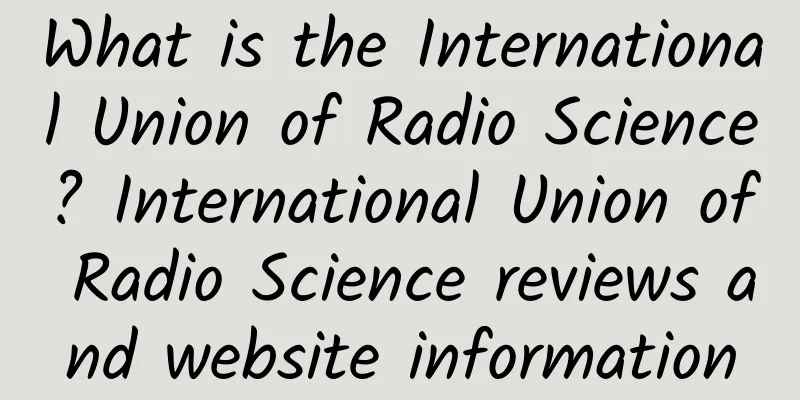What is the International Union of Radio Science? International Union of Radio Science reviews and website information

|
What is the website of the International Union of Radio Science? The International Union of Radio Science (French: l'Union Radio-Scientifique Internationale; abbreviated as URSI) is a member of the International Council for Science. It was founded in 1919 and is a non-governmental academic organization in the field of international radio science. Website: www.ursi.org International Union of Radio Science: Leading the global research in radio scienceThe International Union of Radio Science (URSI) is a member of the International Science Council (ISC) and was founded in 1919. As the most important non-governmental academic organization in the field of radio science in the world, URSI is committed to promoting the development of radio science, promoting international cooperation and exchanges, and providing theoretical support and practical guidance for the advancement of radio technology. Since its establishment, URSI has made remarkable achievements in many fields such as radio wave propagation, astronomy, remote sensing technology, and communication systems, and its influence has spread all over the world. As an open academic platform, URSI not only brings together top scientists and engineers from all over the world, but also continuously promotes innovation and development in the field of radio science by holding international conferences, publishing academic journals, and conducting collaborative research projects. This article will introduce in detail the historical background, organizational structure, main activities and research results of the International Union of Radio Science to help readers fully understand this important international organization. History of URSIThe origin of the International Union of Radio Science can be traced back to shortly after the end of World War I. At that time, radio technology had just emerged, and scientists from various countries began to realize the huge potential of this emerging technology and its wide application value in scientific research. In order to better coordinate international radio science research, URSI was officially established at an international conference held in Brussels, Belgium in 1919. Since its inception, URSI has established the goal of promoting the dissemination of radio science knowledge as its core mission. With the development of the times and the advancement of technology, URSI's research scope has been continuously expanded, gradually covering many cutting-edge fields such as electromagnetic wave propagation, atmospheric electricity, and space weather monitoring. Today, URSI has become an important link connecting radio scientists around the world, and its history has also witnessed the entire process of radio science and technology from its inception to its prosperity. Early development and initial explorationIn the early 20th century, radio technology was still in its development stage, and many basic principles were not yet fully understood. After the establishment of URSI, a series of basic research on the laws of radio wave propagation was quickly organized, laying a solid foundation for subsequent technological breakthroughs. For example, through in-depth analysis of the characteristics of shortwave communication, scientists discovered the ionospheric reflection phenomenon, which made long-distance wireless communication possible. In addition, URSI also actively participates in the formulation of international standards and promotes the standardization of radio spectrum management. These efforts not only promote the popularization and application of radio technology around the world, but also create good conditions for the subsequent development of satellite communications, mobile communications and other fields. Modern expansion and globalization processSince the beginning of the 21st century, with the rapid development of information technology, radio science has faced unprecedented opportunities and challenges. URSI actively responds to the needs of the times, constantly adjusts its research direction, and turns its attention to emerging fields such as new generation communication networks, the Internet of Things, and artificial intelligence-assisted signal processing. At the same time, the organization has also strengthened cooperation with other international organizations to jointly address global issues such as climate change and natural disaster warning. During this process, URSI has always maintained an open and inclusive attitude, encouraging more countries and regions to participate in radio science research. Currently, URSI has more than 70 member countries covering five continents, truly realizing a global layout. URSI’s organizational structureAs a mature international academic organization, URSI has established a complete internal management system to ensure that all work is carried out efficiently and orderly. Its main components include the Executive Committee, Professional Committees and Regional Chapters. Executive CommitteeThe Executive Committee is the highest decision-making body of URSI, responsible for formulating the overall strategic plan and supervising the implementation of various affairs. The committee is composed of the president, vice president, secretary general and several other members, and is renewed every four years. All candidates must be elected by the general assembly to ensure fair and transparent distribution of power. The Executive Committee meets regularly to discuss current hot topics and make corresponding resolutions. For example, at a recent meeting, the committee decided to increase support for young researchers and set up a special fund to support their innovative projects. Professional CommitteeIn order to more effectively promote research in specific areas, URSI has established a number of professional committees, each of which focuses on a specific aspect. The following is a brief introduction to several major professional committees:
Each professional committee operates independently but collaborates with each other to build a complete radio science research system. They regularly publish the latest research reports and organize special seminars to invite industry experts to share their experiences and achievements. Regional ChaptersIn addition to the above core departments, URSI has also established local branches in different countries and regions, namely regional chapters. These chapters mainly undertake the following functions:
In this way, URSI can be closer to grassroots needs, adjust service content in a timely manner, and improve overall operational efficiency. Main activities of URSIAs an international authority in the field of radio science, URSI plans and implements a series of colorful activities every year to enhance communication and cooperation among members and stimulate innovative thinking. The following are some of the most representative activities: URSI General Assembly and Scientific Symposium, GASSGASS is one of URSI's largest and most influential flagship events, held every three years. During the conference, experts and scholars from all over the world gathered together to have in-depth discussions on current hot topics. In recent years, GASS has focused on the following topics:
In addition to the main forum, GASS also set up a number of group discussions and poster presentation sessions to provide young scholars with opportunities to showcase their talents. According to statistics, the last GASS attracted more than 2,000 participants, and the number of submitted papers hit a record high. Young Scientist ProgramIn order to cultivate the next generation of radio science leaders, URSI has launched the "Young Scientist Program", which is open to outstanding young researchers aged no more than 35 years old worldwide. Selected candidates will receive full funding to attend GASS and other international conferences. In addition, URSI will arrange for senior mentors to provide one-on-one guidance to help them grow rapidly. So far, hundreds of young scientists have benefited from it, and many of them have later grown into leaders in their respective fields. Publications and database constructionIn addition to offline activities, URSI also attaches great importance to the development and maintenance of online resources. Currently, the organization publishes two official journals: Radio Science Bulletin and Advances in Radio Science , covering the latest research results in various branches of radio science. At the same time, URSI has also established a huge online database, which contains a large amount of historical documents for users to consult free of charge. This move has greatly facilitated scientific researchers to obtain the information they need and promoted knowledge sharing throughout the industry. URSI's research resultsAfter more than a century of hard work, URSI has achieved remarkable achievements in many key areas. The following are just some of the representative achievements: Radio wave propagation modelBased on the accumulation of long-term observation data, URSI has successfully developed a mathematical model that accurately describes the propagation behavior of radio waves. This model comprehensively considers the influence of multiple factors such as topography and climate conditions, and can accurately predict the attenuation law of signal strength with distance. This achievement has been widely used in radio station site selection, wireless communication link design and other aspects. Ionosphere Monitoring TechnologyAs part of the Earth's atmosphere, the ionosphere has a direct impact on the quality of radio communications. To this end, URSI took the lead in forming a multinational cooperation team specializing in the study of the dynamic characteristics of the ionosphere. After years of research, they invented a new radar system that can monitor the distribution of ionosphere electron density in real time, providing an important reference for weather forecasts and space missions. Radio astronomy observationsWith the help of advanced radio telescope arrays, URSI has helped scientists uncover many mysteries of the universe. For example, by analyzing radio wave signals emitted by distant galaxies, researchers confirmed the existence of supermassive black holes for the first time and provided a preliminary explanation of their formation mechanism. ConclusionIn summary, as a benchmark organization in the field of global radio science, the International Union of Radio Science (URSI) has played an irreplaceable role in promoting scientific and technological progress with its long history and outstanding innovation capabilities. Whether in theoretical research or practical application, URSI is at the forefront of the industry and leads the development direction. Looking into the future, with the advent of a new round of scientific and technological revolution, radio science will have a broader space for development. We have reason to believe that under the leadership of URSI, this discipline will surely achieve more brilliant achievements and bring benefits to human society. If you want to know more about URSI, please visit its official website: www.ursi.org . |
<<: What is Open Road Pictures like? Open Road Pictures reviews and website information
Recommend
How to grow jade tree? How to grow jade tree
Jade tree is a beautiful foliage plant with green...
How is ooVoo video chat? ooVoo video chat review and website information
What is ooVoo video chat? ooVoo is a well-known Am...
Ingredients and steps of taro porridge Benefits of taro porridge
Every autumn, a large amount of taro will be avai...
The benefits of eating coconut husk
Coconut is a fruit that is very nutritious. After...
How to eat dragon fruit? The correct way to eat dragon fruit
Dragon fruit is a nutritious tropical fruit. It i...
Pictures and eating methods of wild vegetable February orchid
The wild vegetable February orchid is a fine prod...
How is the School of Journalism Practice? Reviews and website information of the School of Journalism Practice
What is the website of the Institute of Journalism...
The effects and benefits of pumpkin cashew soup
Pumpkin cashew soup has been very popular recentl...
Tutorial on the ingredients and steps of making Sachima
Sachima is a kind of national dessert. Now it is ...
What is David Hall's photography like? David Hall's photography reviews and website information
What is David Hall Photography? David Hall Photogr...
What is Sampdoria Football Club like? Sampdoria Football Club reviews and website information
What is the website of Sampdoria Football Club? Sa...
Ingredients and steps for making sesame pumpkin porridge
Pumpkin is a delicious and nutritious ingredient....
How to make pineapple jam How to eat pineapple jam
Everyone is familiar with pineapple. They know th...
How to grow cockscomb How to grow cockscomb
Cockscomb is an ornamental plant that people are ...
What is the British Labour Party like? British Labour Party reviews and website information
What is the website of the British Labour Party? T...









